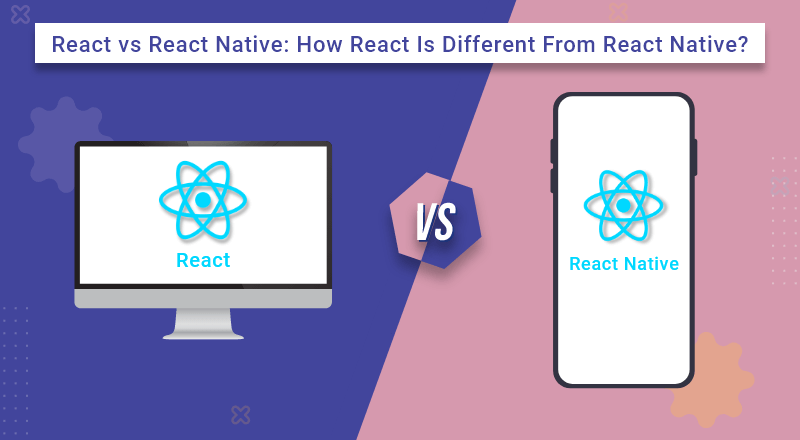React vs React Native: How React Is Different From React Native?
UpdatedFebruary 19th, 2025

Trying to decide between web and mobile app development? Let’s simplify the choice between React and React Native for you. React.js is perfect for building web applications and creating smooth user interfaces with its easy-to-manage components and state management. It powers many of the interactive websites you enjoy, making content flow smoothly across your screen.
Switching to React Native, you use the same skills to build mobile apps that work well on any device. It’s like turning your JavaScript knowledge into mobile apps with great animations and easy interactions.
Choosing between React and React Native is more than just picking a technology; it’s about selecting the right tool for your project. Whether you’re focusing on web development or mobile app creation, these two technologies provide everything you need to bring your ideas to life.
In this blog, we will discuss the ins and outs of React vs React Native so that you can have a fair idea of which technology will better work for your project.
Let’s start with the introduction of both these technologies.
What is ReactJS?
React is also known as Reactjs or React.js.
React is a free and open-source front-end JavaScript library. It is mainly used for building user interfaces based on UI components. React is also used as a base in the development of single-page applications (SPA) and mobile apps.
React web framework is designed specifically for building user interfaces and frontend parts for web applications. Thus, it requires additional libraries to build an end-to-end application.
React was created by Jordan Walke, a software engineer at Facebook. It was open-sourced at JSConf US in May 2013.
Also Read: ReactJS Developer: Role, Responsibilities, Skills, Salary And Lot More
What is React Native?
React Native is an open-source UI software framework created by Meta Platforms, Inc. It enables developers to use React to build truly native apps for Android, iOS, macOS, Web, Windows, and UWP.
It is popular for its native development capabilities and cross-platform features that make development faster, easier, and cost-effective.
It offers a fully-native experience using a core set of platform-agnostic native components. React components interact with native APIs and wrap native code using React’s declarative UI paradigm and JavaScript.
React Native has been successful at raising the bar for cross-platform mobile app development with its powerful features.
A lot of developers around the world use React Native for native mobile app experiences that are easy to build, scale, and deliver.
What is the Difference Between React JS and React Native?
Before we begin, let us first clarify the fundamental concept.
React targets the web whereas React Native targets mobile app development using React. However, Meta and the community have extended this technology to desktop and virtual reality, making React Native’s many platform visions a reality.
Highlighting Key Difference
Architecture
One of the key differences between React Native and React lies in its architectural design. React makes use of Virtual DOM. Simplifying this, React makes it easy for the pages to be rendered with subcomponents that are changed or updated.
React creates an in-memory data structure cache, computes the resulting difference, and then updates the browser’s DOM. This selective rendering of changed subcomponents makes React super fast. This process is called reconciliation.
React Native does not work this way. It doesn’t manipulate the DOM through the Virtual DOM. Instead, it runs in the background process and communicates with the native platform through serialized data over an asynchronous bridge.
Library vs Framework
ReactJS is a library and not the whole framework. React is fundamentally a JavaScript library to create a smooth, high-performing, and engaging UI layer of an application. It is specifically designed for building a user interface. React Native is the framework that focuses on app development that runs on many platforms.
React Native is a platform to build native apps using JavaScript.
Animations
When we talk about React JS and React native differences, animations are on the list. React offers more animations using CSS and JavaScript libraries. React Native, on the other side, depends on API and a built-in library for animation.
User Interface
React Native does not use HTML tags. In React Native, JavaScript threads are used to manipulate native views and almost every HTML tag has an equivalent React Native component.
React, on the other side, uses HTML tags. ReactJS renders HTML to the web page by using ReactDOM. It uses JSX, and JavaScript XML which makes it easier to write or add HTML in React.
Styling
ReactJS makes use of CSS for Styling whereas React Native styling has a similar syntax to CSS for styling elements.
In React Native, you can style your applications using JavaScript and StyleSheet. A StyleSheet is an abstraction similar to CSS Stylesheets.
Security
React JS provides high security compared to React Native as React Native deals with native APIs to render platform-specific views and build cross-platform apps.
React vs React Native: A Quick Comparison
| Parameters |
React |
React Native |
| Initial Release |
2013 |
2015 |
| Focus Area |
Mainly for web development |
Targets mobile apps and cross-platform app development |
| Developers |
Meta and Community |
Meta and Community |
| Platform |
Web |
Android, iOS, macOS, Windows, UWP, VR |
| Type |
Library |
Application Framework |
| App Performance |
JavaScript library for web |
Close to native apps |
| Development Model |
Free and Open-source |
Free and Open-Source |
| UI rendering |
DOM |
Platform-specific APIs |
| Security |
Optimum |
Low |
| Learning Curve |
Steep |
Easy |
| Code Reusability |
Due to virtual DOM |
Cross-platform and provides maximum reusability by partially sharing the code between platforms |
| Used By |
Uber, Yahoo, Airbnb, Facebook, Shopify, Amazon, Udemy, Pinterest, Netflix, and many more |
Instagram, Facebook, Coinbase, Tableau, Oculus, FlipKart, Discord, Skype, Tesla, Bloomberg, Walmart, Wix.com, Salesforce, and so on. |
We have seen how React And React Native are similar and also discussed the difference between React and React native.
React is the heart of React Native, and we can say that React Native is just an extended part of React.
React Native vs React: Advantages and Disadvantages
Now, let’s see the advantages and disadvantages of both these technologies so you will have a better idea of their usage and applications.
Advantages of React
- Powerful JavaScript library for creating beautiful UIs
- Reusable components that help create web apps faster
- High-performance web apps
- Great community support
- Easy to learn and use
- Component-based architecture
- A wide range of additional libraries and extensions
- SEO-friendly functionalities
- Faster loading of web pages
- One-way (unidirectional) data binding
Advantages of React Native
- Cross-platform compatibility
- JavaScript to build native apps
- Hot Reloading for instantly viewing the changes
- Faster and efficient UI development
- Modular architecture for separation of concerns
- Reliable, flexible, and supports many platforms
- Easy access to third-party libraries and pre-built components
- A large community of developers
Each framework or technology has its pros and cons. Let’s see the limitations of each.
Disadvantages of React
- It is just a library, not a full-featured framework
- Constant evolvement and changes in React make developers regularly relearn things
- Not proper documentation
- JSX is not preferred by several developers due to its complexity
What are the Disadvantages of React Native?
- Debugging issues due to different environments’ package compatibility
- Lack of custom modules
- Native resources are still required
- Steep learning curve
- Low security due to JavaScript
- A small number of libraries and ready-made components
React and React Native: Which is Better?
The answer is quite clear as the usage of both these technologies is different. React is used for building powerful, reliable, and feature-rich web applications, and React Native which is based on React, is used for cross-platform app development.
React and React Native – both power many world-famous applications and are widely used to create modern, scalable web and mobile apps.
React has played a crucial role in the increased popularity of JavaScript for front-end development. It is supported by contributions from individuals and leading organizations around the world.
It is one of the big open-source communities in the development world to make app development faster, more efficient, and more secure.
SPEC INDIA, as your single stop IT partner has been successfully implementing a bouquet of diverse solutions and services all over the globe, proving its mettle as an ISO 9001:2015 certified IT solutions organization. With efficient project management practices, international standards to comply, flexible engagement models and superior infrastructure, SPEC INDIA is a customer’s delight. Our skilled technical resources are apt at putting thoughts in a perspective by offering value-added reads for all.
Delivering Digital Outcomes To Accelerate Growth
Let’s Talk
 One tree
One tree 








